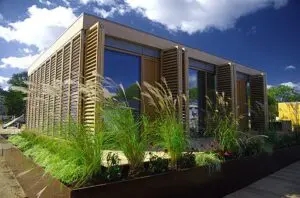For testing:
- Heat It Up! temperature tracker
- Rulers (one per pair)
- Thermometers (one per pair, plus one extra for the class to be used to track outdoor temperature)
- Timer
Provide a variety of building materials for students to explore. Some possibilities include:
- Air pillows
- Aluminum foil
- Black fabric, paint, or paper
- Bubble wrap
- Cardboard boxes
- Clear plastic recyclable containers (that can be cut up to make windows and doors)
- Craft sticks
- Disposable cups (paper, plastic)
- Foam board
- Glue
- Markers
- Newspaper
- Paper (white, construction, cardstock)
- Quilt batting
- Scissors
- Stones
- Styrofoam
- Tape (duct, masking, packing)
Design a model passive solar house that will heat up and retain heat for as long as possible.
Background
The idea of using the sun to heat buildings has been around for centuries, but the first modern passive solar house was engineered in Germany in 1990. As of 2016, there were over 60,000 worldwide, and the number continues to grow. Passive solar heating is different from active solar heating, which utilizes solar panels to collect the sun’s energy, and other external devices to store and convert the energy into usable power. Passive solar heating relies exclusively on design and materials to collect and store heat and use it directly. It does not convert heat energy to usable power. It works best for smaller houses, in moderate climates, and in areas that receive plentiful sunshine.

Cherokee Lofts, a residential building in Los Angeles, uses passive solar design.
Calderoliver, CC BY-SA 3.0, via Wikimedia Commons
How to Use This Activity
- Review these Leader Notes. Then decide how to group students to complete the activity. This challenge works well for students working in pairs, if possible. They can collaborate, discuss their design, build their house, and enjoy testing together.
- Make copies of the Heat It Up! temperature tracker and Student Instructions so that each student has their own copies to reference during the whole-group activity.
- Gather the materials and decide how you’ll distribute them to the group. Consider setting up a materials table in an accessible area of the room where students can take what they need.
- Scout an outdoor location for testing. It should be a flat, sunny spot that borders a similar space with shade and where prototypes will be undisturbed for at least 40 minutes.
Success Criteria
- The house must heat up at least 20 degrees above the outdoor temperature after 20 minutes in the sunshine.
- The house must retain heat, with at least a 10-degree difference between the outdoor and house temperatures after 20 minutes in the shade.
Engineering Constraints
- The house must contain at least one door and one window that can be used to view the thermometer.
- The house must be at least six inches tall.
- The house must use at least two different types of insulation.
Introduce the Challenge
- Activate students’ prior knowledge by showing photos of greenhouses, such as the Greenhouse at Nuffield Place or the Palm House at the University of Helsinki Botanical Garden. Ask students questions such as:
- What is a greenhouse?
- Have you ever been inside a greenhouse? What was the temperature like?
- How does a greenhouse work? Does it stay warm at night?
- Why do people use greenhouses?
- Explain that greenhouses are made of transparent materials, such as glass or plastic, so that they can capture heat from the sun. Sunlight passes through the walls and roof, creating thermal energy, or energy that is generated when something heats up. All objects in the greenhouse store thermal energy, including plants, soil, and the building materials themselves—the greenhouse floor, glass, concrete, and bricks. The thermal energy stored in the plants and building materials helps keep the greenhouse warm, even after the sun sets.
- Introduce the concept of passive solar heating. Explain that to reduce the amount of gas and electricity used to heat and cool buildings, engineers and architects are rethinking how houses are built. They are creating new designs that use energy-absorbing materials that can capture heat from the sun, and insulative materials that can retain it. Passive solar heating is different from installing solar panels, which collect the sun’s energy and convert it into usable power for other purposes.
- Tell students that in today’s challenge, they will build a model house that uses passive solar heating. Present the design challenge and define the success criteria and engineering constraints.
Brainstorm Solutions
- Introduce the materials that students can use to build their houses.
- Have students work in pairs to brainstorm and sketch their house designs. Encourage them to browse the materials and consider which will heat up quickly and retain heat.
- Remind students of the design constraints and success criteria, if needed.
Build, Test, Redesign
- Give students time to experiment with different materials and build. As they work, circulate and provide support. To encourage students to think more deeply about the challenge, ask guiding questions such as:
- Which materials are you using? How will those materials help your house heat up or retain its heat?
- How can you test materials before using them in your design?
- Does the size of the house matter? What are the pros and cons of a small house versus a larger house?
- Think about the greenhouse example. What could you put inside your house to help it retain heat?
- Encourage students to test as they build and redesign as needed. This might involve taking their house (with thermometer) outside, placing it in a sunny spot, and observing for a few minutes to see how quickly it absorbs heat. If their house isn’t functioning as planned, they will need to make adjustments or change their design entirely.
- When students are ready for the final test, go outside and set up. Here’s what to do:
a) Place a thermometer in a shady spot to determine the outdoor temperature. (Note: this thermometer must be kept in the shade for the entire 40-minute test.) Read the temperature aloud and have students mark it on their graphs in black, on line 0, as the starting temperature.
b) Prototypes should be placed on a flat, sunny surface in a low-traffic area. They will not be moved for the duration of this part of the test (20 minutes).
c) Students should place a thermometer inside their house. They must be able to read the thermometer through the door or window and without opening, moving, or disturbing the prototype. Explain that they don’t want the warm air inside to escape and skew the results. (Note: they may need to tape the door, window, and roof closed so they don’t pop open during testing.)
d) When students are ready, have them “close up” their houses and begin timing. Set the timer for 5 minutes.
e) After 5 minutes, have students do a temperature reading inside their houses (without opening up the doors or windows) and mark the result on their graphs in a color of their choosing. Also check the outdoor temperature, announce it, and have students record it on their graphs in a different color.
f) Have students continue taking temperature readings every 5 minutes for an additional 15 minutes. Remember to announce the outdoor temperature each time. Students should record both readings on their graphs.
g) Without opening their houses, have students move their prototypes to the shade. Set the timer for 5 minutes and take another temperature reading. Have students record the temperature inside their houses and the outdoor temperature on their graphs.
h) Continue taking and recording the temperature every 5 minutes for an additional 15 minutes. Then have students collect their prototypes and head indoors.
- If your students are new to graphing, show them how to connect the dots, using rulers, to make line graphs on their temperature trackers. Have them use one color to show the change in temperature inside their prototype. Have them use a different color to show the change in outdoor temperature.
- (Optional) Older students can calculate the delta D, or the difference in temperature, between the two readings. Have them subtract the outdoor temperature from the temperature inside their prototype. For example, if the outdoor temperature is 75 degrees and the temperature inside the prototype is 95 degrees, the delta D is 20 degrees. Ask students to identify trends that they see in the delta D numbers.
Reflect
- Bring students together to discuss and share. Ask questions such as:
- How hot did your house get? (Record temperatures on the board.)
- What materials do you think worked the best at raising the temperature inside your house?
- How well did your house retain, or keep, its heat?
- What did you notice about your graph? Did the results surprise you?
- Read the success criteria aloud and have students raise their hands if they met them.
Engineering & Science Connections
Engineers design ways to regulate temperatures in buildings using passive solar heating. Passive heating uses the sun’s energy, but solar panels aren’t required. Instead, insulative materials and innovative design regulate temperatures. Engineers consider factors such as energy-absorbing materials to collect sunlight, such as insulation, energy-efficient windows, ventilation, air-tight construction, and insulative building materials that retain heat, such as brick, stone, concrete, and tile. Many houses that use passive solar heating are bright and sunny because they maximize exposure to light. They are also environmentally friendly because they reduce the use of fossil fuels and the emission of greenhouse gases. However, there are downsides to passive solar heating. Since passive solar heating is dependent on sunlight, there can be fluctuations in the amount of heat produced. Despite this, scientists and engineers believe that passive solar heating could supply a third of the heating that a family needs for a year, significantly reducing their reliance on fossil fuels and creating an eco-friendly heating solution.

This award-winning passive solar house was designed for humid, subtropical climates.
Jeff Kubina from the milky way galaxy, CC BY-SA 2.0, via Wikimedia Commons
- Hold a do-over! Have students use what they learned from the first test to rebuild their prototypes. They might select different materials to use in their designs, or they might alter the size or shape of their houses. They might choose to keep their initial prototypes and build something completely new to test.
- Set new parameters. Challenge students to redesign their prototypes to heat to a comfortable temperature. Can they warm their houses but prevent them from getting too hot?
Grades 3–5
4-ESS3-1 Obtain and combine information to describe that energy and fuels are derived from natural resources and their uses affect the environment.
4-PS3-4 Apply scientific ideas to design, test, and refine a device that converts energy from one form to another.
5-ESS3-1 Obtain and combine information about ways individual communities use science ideas to protect the Earth’s resources and environment.
3-5ETS1-1 Define a simple design problem reflecting a need or a want that includes specified criteria for success and constraints on materials, time, or cost.
3-5ETS1-2 Generate and compare multiple possible solutions to a problem based on how well each is likely to meet the criteria and constraints of the problem.
3-5ETS1-3 Plan and carry out fair tests in which variables are controlled and failure points are considered to identify aspects of a model or prototype that can be improved.
Grades 6–8
MS-PS3-3 Apply scientific principles to design, construct, and test a device that either minimizes or maximizes thermal energy transfer.
MS-ESS3-3 Apply scientific principles to design a method for monitoring and minimizing a human impact on the environment.
MS-ETS1-1 Define the criteria and constraints of a design problem with sufficient precision to ensure a successful solution, taking into account relevant scientific principles and potential impacts on people and the natural environment that may limit possible solutions.
MS-ETS1-2 Evaluate competing design solutions using a systematic process to determine how well they meet the criteria and constraints of the problem.
MS-ETS1-4 Develop a model to generate data for iterative testing and modification of a proposed object, tool, or process such that an optimal design can be achieved.






Thank you! Your submission is processing.